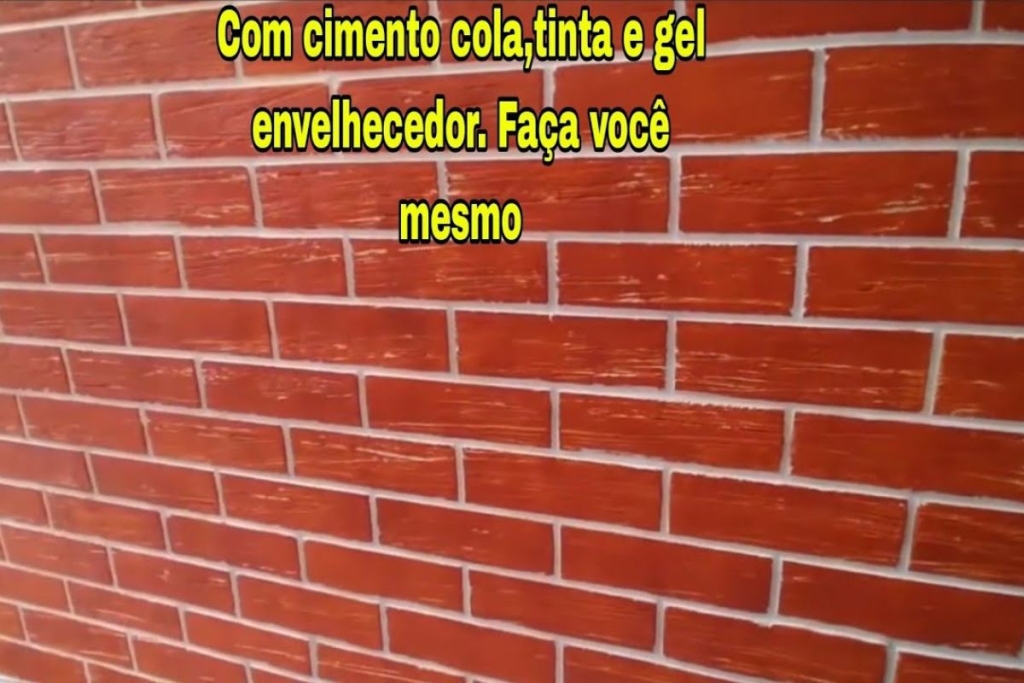Want to add a rustic and charming touch to your wall without spending a lot? Today I'm going to teach you how to create an incredible effect little brick using cement glue, a simple and economical technique that will completely transform the environment of your home.
Don't worry if you don't have any experience in renovations, this step-by-step guide is easy to follow and you will see how it is possible to achieve a professional result with affordable materials. Let's go!
Step by Step to Create the Brick Effect with Cement Glue

Preparing the Wall
First of all, make sure the wall is clean and free of imperfections. If necessary, sand the surface to make it even. This will help ensure that the cement adhesive adheres better to the wall, providing a more durable and uniform finish.
Mixing the Cement Glue
The consistency of the cement glue is essential to the success of the project. For a 10 kg package, add 4 liters of water and mix well until you get a thick paste. If you are mixing by hand, you can add a little more water to make it easier to work with. Be sure to follow the manufacturer's instructions, as the amount of water may vary slightly depending on the brand of cement glue.
Application of Cement Glue
Using a spatula, apply the cement glue to the wall in layers of approximately 2 to 4 mm. Let it dry for about 10 minutes. Then, use a broom to create textures and patterns that resemble bricks. This simple trick gives a beautiful, rustic effect. You can vary the pressure and direction of the broom to obtain different patterns and textures, giving your wall a personalized touch.
Shaping the Shape of Bricks
Once the cement has started to dry, use a ruler and a precision knife to mark the outlines of the bricks. Measure and mark carefully to ensure that the “bricks” are even. This will help maintain the realistic and organized look of your faux brick wall.
Finishing with Paint and Varnish
Once dry, sand the surface with fine sandpaper to smooth out the texture and remove any excess cement glue. Apply two coats of a thinned paint (half water, half paint) to penetrate the grooves. Add a little PVA glue to the mixture to improve adhesion. The thinned paint will allow the grooves to be visible, highlighting the texture of the cement glue.
Finally, you can apply a protective varnish to increase the durability and make the wall easier to clean. This will also help protect the paint and keep it looking fresh for longer.
Tips for a Professional Finish
- Use of Decorative Gel: Add white decorative gel to further highlight textures. The gel can be applied with a brush, allowing greater control over the amount and location of the product.
- Save with Simple Materials: Em vez de usar fitas caras, utilize fita crepe fina para demarcar os tijolos. A fita crepe é fácil de aplicar e remover, e ajuda a criar linhas retas e limpas.
- Drying Care: Don't let the cement dry completely before sanding to avoid difficulties in finishing. Work in small sections to ensure that the cement is always at the ideal working point.
Additional Suggestions
- Escolha das Cores: Experiment with different color combinations for the cementitious mortar and finish paint. Darker colors can create a more dramatic, modern effect, while lighter shades can create a softer, more traditional look.
- Adding Texture: In addition to the broom, you can use other objects to create interesting textures, such as sponges, old toothbrushes or even crumpled plastic bags.
- Brick Customization: If you want to give it a more realistic touch, add small imperfections to the bricks, such as cracks or wear, using a spatula or a fine brush.
Frequently Asked Questions
1. How long does it take to apply the brick effect?
The entire process can take one to two days, depending on the size of the wall and weather conditions. Allow extra time for drying between coats of cement and paint.
2. Can I use any type of cement glue?
Yes, you can use AC1, AC2 or AC3, but AC2 is usually the most suitable for this type of work due to its good adhesion and ease of handling.
3. Do I need special tools to apply the cement glue?
No, basic tools like a putty knife, broom, sandpaper, and masking tape are sufficient. Investing in a ruler and precision knife can help you achieve a more detailed finish.
4. Does diluted paint really work?
Yes, thinned paint penetrates the grooves better and, when mixed with PVA glue, improves adhesion and durability. This technique also helps to create a smoother, more even finish.
5. How do I keep the wall clean after applying the effect?
Use a soft sponge and warm water to clean the wall. Avoid harsh chemicals that can damage the paint and cement.
6. Can I apply this technique in outdoor areas?
Yes, but it is recommended to use a sealant after painting to protect against weathering. The sealant will help maintain the integrity of the wall and protect against moisture and temperature fluctuations.
Did you like this amazing tip? If so, share it with your friends and on your social networks. Leave your comment below and your suggestions. Receive it daily here on our website. Blog of ideas and tips free and follow us on Google News too. Thank you!